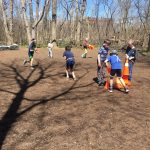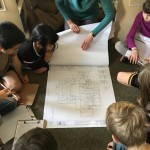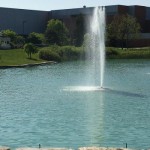Much of our work, as of late, has been focused on the Ypsi-Arbor Student Forest Project. The work is a collaboration with We Are The Forest, a local non-profit that focuses on education and reforestation and students from Ypsilanti New Tech High School.
The project takes a bioregional approach to understanding the Ypsi-Arbor Corridor and focuses on the shared green spaces and watershed. One goal of the project is to create new connections with and tell new stories about the Ypsi-Arbor Corridor. They will be documenting these stories and sharing them with the broader community through interactive story maps. The other goal is to complete two green infrastructure projects on their respective campuses using trees and the ecosystem services they provide to improve air and water quality as well as provide energy savings.
Together we will learn more about the importance of trees and forests to ecosystems, study the history of our local area, and plant trees on our respective campuses.
Our class began the project by traveling to Ypsilanti New Tech High School where we learned more about some of the challenges the school faces regarding flooding on campus and the different trees they have planted so far to improve storm water management and provide energy savings to the school.
After the presentations and a walking tour of part of the grounds, we were invited to play Capture the Flag in the beautiful forest on their property.
We also invited the students to join us on our campus to share the work we’ve been doing. Part of this work included designing a game that highlighted the different relationships in a healthy forestial ecosystem. Working through the design process (Empathize, Define, Ideate, Prototype, and Play/Test) we defined the elements of our game and games in general. After identifying key ideas, goals, core mechanics and materials, we play/tested, revising based on our experiences.
The current version of the game, Ecosystem Infection (working title) pits native and invasive trees against each other as they work with mycelium to accumulate nutrients and establish themselves in their respective zones.
After sharing some of the key ideas with the students from Ypsilanti New Tech High School, we invited them to play the game. While some played, others helped us mark invasive species that we will clear before planting more native trees at the end of the project.
Later in the week, we joined our Ypsilanti New Tech friends, as well as Nate Ayers (We Are the Forest), Jason Hogans, and local historian Matt Siegfried for a “Surthrival Course” at County Farm Park. We began with an introduction by Matt on the history of County Farm Park and Washtenaw Avenue, how the land has been used over time and how the changes reflected changes in societal values.
Nate showed us how to use common plastic bags that can, unfortunately, be found all over to build a solar water still to collect water in case of emergency. Taking advantage of the condensation that happens overnight, we learned how to set up the bag to collect this water and save it for later use (after boiling.)
Jason Hogans, who specializes in primitive survival techniques and is a musician shared some of his history and the ways that he uses nature as both an influence and actual samples in his music. He then helped us build shelters using large and small branches as well as leaves and bark that would be useful should we find ourselves in the woods overnight.
After shelter building, we spent time with Jason learning how to build fires using common plants and other materials that could be found in the area.
We capped it off with hot dogs (both beef and vegetarian) and fresh smoothies with mint found in the area.
As the day drew to a close, we left with new perspectives on the ways we can interact with the natural spaces that surround us.




















































































































